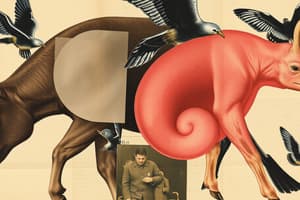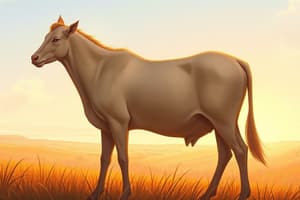Podcast
Questions and Answers
Which stage in animal reproduction involves the fusion of gametes?
Which stage in animal reproduction involves the fusion of gametes?
- Sexual reproduction (correct)
- Gestation
- Maturation
- Asexual reproduction
What is the term used to describe the time from conception until birth in animals?
What is the term used to describe the time from conception until birth in animals?
- Gestation period (correct)
- Ovulation period
- Menstrual cycle
- Fetal development
Which of the following is responsible for producing sex cells in animals?
Which of the following is responsible for producing sex cells in animals?
- Gonads (correct)
- Accessory reproductive organs
- Digestive system
- Maturation glands
What is one factor that can influence the length of gestation periods in animals?
What is one factor that can influence the length of gestation periods in animals?
Which type of reproduction involves the development of new individuals through growth and maturation?
Which type of reproduction involves the development of new individuals through growth and maturation?
What do accessory reproductive organs do in animal reproduction?
What do accessory reproductive organs do in animal reproduction?
Which type of reproduction involves the union of male and female sex cells?
Which type of reproduction involves the union of male and female sex cells?
What is the main difference between asexual and sexual reproduction?
What is the main difference between asexual and sexual reproduction?
Which organs are examples of gonads?
Which organs are examples of gonads?
Where does fertilization usually occur in internal fertilization?
Where does fertilization usually occur in internal fertilization?
What is the primary purpose of pair bonds in animals during sexual reproduction?
What is the primary purpose of pair bonds in animals during sexual reproduction?
Why do some experts argue that a true form of asexual reproduction does not exist in higher animals?
Why do some experts argue that a true form of asexual reproduction does not exist in higher animals?
Flashcards are hidden until you start studying
Study Notes
Animal Reproduction: Gestation Periods, Organs, Asexuality, Sexuality, Fertilization
The process of animal reproduction involves several stages, including the formation of gametes (eggs and sperm), their fusion during fertilization, and the development of new individuals through growth and maturation. This complex system is essential for the continuation of life cycles across species. In this article, we will explore various aspects of animal reproduction: gestation periods, reproductive organs, asexual reproduction, sexual reproduction, and fertilization.
Gestation Periods
Gestation refers to the time from conception until birth in animals. It varies greatly among different species due to factors such as body size, diet, and environmental conditions. For example, elephants have one of the longest gestation periods, with pregnancy lasting around two years, while some small mammals like shrews can give birth just a few weeks after mating. Understanding these differences is crucial for predicting when offspring might arrive, ensuring maternal care, and managing wildlife populations.
Reproductive Organs
Animals possess specialized structures responsible for carrying out various functions related to procreation. These organs typically fall into two categories—gonads and accessory reproductive organs. Gonads produce sex cells (also known as gametes) like eggs or sperm. Accessory reproductive organs play supporting roles in facilitating successful fertilization. Examples of gonads include ovaries in females and testes in males, while examples of accessory organs range from uteruses and vasa deferentia to seminal vesicles and bulbourethral glands.
Asexual Reproduction
Asexual reproduction occurs without the involvement of another individual's genetic material. Instead, a single organism produces multiple copies or clones of itself by dividing its own cells repeatedly. This method allows rapid population expansion and is found among simple multicellular organisms such as bacteria, fungi, plants, and certain animals like hydras and flatworms. However, many experts argue that a true form of asexual reproduction does not exist in higher animals because all forms involve mitosis rather than meiosis, meaning no egg and sperm are produced.
Sexual Reproduction
Sexual reproduction, also called conjugal reproduction, involves the union of male and female sex cells (gametes). Sperms from the male unite with eggs from the female within a protective structure called a zygote. After fertilization, the zygote develops into an embryo before it hatches or is born. This process results in genetically diverse offspring since each child inherits DNA from both parents. Animals form pair bonds, often referred to as monogamy, which helps ensure paternity and parental investment.
Fertilization
Fertilization is the process whereby the fusion of male and female gamete nuclei takes place. It results in the creation of a diploid cell called a zygote. Fusion usually occurs outside the mother's body (external fertilization), although in some vertebrates, fertilization can occur internally (internal fertilization); after internal fertilization, the developing embryo is implanted deep inside the mother's womb for further development.
In conclusion, understanding animal reproduction is vital for preserving biodiversity, conserving endangered species, and managing human impacts on natural ecosystems. By examining key elements like gestation periods, reproductive organs, asexual versus sexual reproduction pathways, and steps involved in fertilization, researchers can gain insights into how specific species reproduce under varying biological and ecological circumstances.
Studying That Suits You
Use AI to generate personalized quizzes and flashcards to suit your learning preferences.




